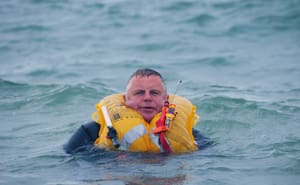The old adage holds true: “One hand for oneself, and one for the ship.” Boaters spend a lot of time, money, effort and thought on preventing what is an exceedingly rare occurrence on larger cruising-sized vessels.
One reason we all dread going overboard offshore is that experienced boaters recognize the extreme difficulty of first finding the victim — assuming anyone is on board to notice — and then getting that person back on board the boat. Just think of all the times you have had a hat blow off and then tried to retrieve it. How successful were you? I know I have lost a lot of hats, fenders and other items that blew off the boat, never to be seen again. Try jumping off your boat in a peaceful harbor on a warm day without the swim ladder deployed and attempt to get back on board, or try hauling each other out of the water up onto the deck. Now imagine the struggle involved in the dark of night with the wind howling, possibly just after you have rushed up from down below as a loved one disappears into the blackness astern.
The first priority, therefore, is stay on board no matter what. Safety harnesses, jack lines, well-placed handholds, care and pre-planning of every move after dark are by far the most important tools in thinking about how to deal with a man overboard (MOB) — don’t let it happen in the first place!
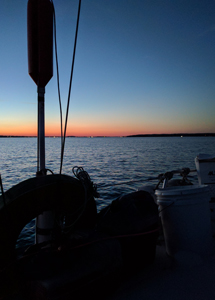 |
|
In the gloom of night, deploying gear can be tricky without practice. |
|
John Kettlewell |
But, the unthinkable happens, despite your best precautions. What next? Man overboard procedures include three major steps: 1) prevention, 2) location, and 3) retrieval.
We briefly discussed the first step, which is by far the most important, with number 2 requiring careful thought and planning in order to be able to successfully carry out number 3. Locating an MOB is the key to initiating a successful rescue.
Location, location, location
On my current boat, we take a layered approach to maintaining contact with and locating the victim. The first layers are low-tech basics that every voyaging boat should have: markers, flotation devices and navigation. There are many specialty electronic devices that can be of assistance if the victim has them with him/her, but with safety gear one needs to assume that, for many reasons, any single piece of safety equipment may not be where it should be, may not work for some reason or may not even be available at the time. A couple days ago, one of my boat hooks broke off while catching the mooring — imagine if that had been the one to snag a floating crewmember! Fortunately, we already had the second boat hook on deck and grabbed the mooring with it.
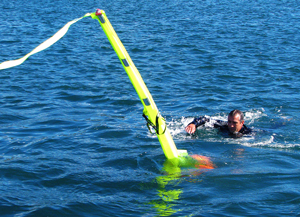 |
|
An inflatable MOB pole from Dan Buoy. |
|
Courtesy Dan Buoy |
For an MOB, our boat plan is to instantly toss flotation cushions over the side and a couple of life rings, followed by the deployment of an MOB pole like the traditional ones from Forespar or Jim-Buoy with an attached life ring and flashing strobe light. US Sailing has required these for years on board offshore racing boats, along with a whistle and a small drogue to keep the whole mess from blowing away. However, as of January 2014, US Sailing also allows self-inflating MOB devices, such as the Dan Buoy, which packages all of the essential gear in a way that makes it easier to store, quick to deploy and also better protected from the weather. Of course, like all mechanical/electrical devices, inflatable units must be serviced on schedule in order to be trusted. A good primer on how to equip an offshore boat with safety gear is available from US Sailing (www.ussailing.org/safety/equipment-and-requirements/).
The photo of my boat’s stern at sunset (see above) illustrates why a self-contained MOB pole/rig like the Dan Buoy has an advantage over a traditional fixed pole, flag, life ring, light, etc. Figuring out how to attach all that stuff on the stern in a way that is secure in heavy seas, yet quickly deployable, can be a challenge. In addition to the safety gear, most cruising sterns become the catch-all platform for an abundance of other boat junk like grills, fenders, flags, dinghies, etc. On many boats, that leaves everything fully exposed to the sun and weather, requiring careful annual maintenance and frequent replacement to make sure the gear will work properly when needed. Yet, it’s also true that a standard MOB pole itself is dependable in that it doesn’t require batteries or maintenance: Get it in the water and it works.
Other inflatable options include the Switlik MOM 8-A and 8-S packs that include inflatable flotation rings with integrated lifting straps, along with an inflatable spar for visibility. A flashing light is mounted on the top of the inflated spar, providing much greater visibility than a light at water level.
 |
|
The classic MOB pole from Forespar. |
|
Courtesy Forespar |
A neat tossable option is the ThrowRaft, which is much smaller than life rings or cushions and designed for throwing. It is claimed the TD2401 unit can be hurled 40 feet; when it reaches the victim, they can jerk the handles to pop open a tiny inflatable raft. Another tossable item is the Mustang Rescue Stick. Fourteen inches long and weighing 15 ounces, this unit can be thrown up to 100 feet to a victim in the water. When it gets wet, it automatically inflates into a horseshoe life vest.
Of course, the need for flotation is reduced if you are already wearing a PFD. Since even the slimmest PFD tends to be constricting, the best solution for many voyagers is an inflatable unit like the Stearns FastPak 33, which also has reflective tape to make it more visible when hit by a spotlight. Unlike a solid vest, with an inflatable unit there is no material to bind across your chest or back or constrict at the shoulders, making it more likely that you will actually wear the unit while on deck.
MOB accounts frequently point out how the lack of reliable light with a person in the water can be deadly. A powerful strobe attached to the MOB pole, like the Forespar WL-1 Water Light or the ACR SM-2 Marker Light, would make a huge difference. Strobes are visible for miles at night. A simple but effective addition to your MOB gear would be a small, waterproof LED flashlight attached to the person’s life jacket or in a foul weather gear pocket. It is also important to frequently check the light attached to the MOB pole to make sure it is working properly and has fresh batteries. After one long offshore trip, I was horrified to find out the battery had died in our MOB strobe attached to the pole.
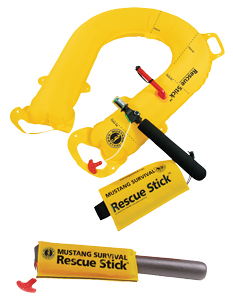 |
|
The Rescue Stick throwable device. |
|
Courtesy Mustang |
A particularly useful light is the Weems & Plath SOS Distress Light, which is designed to replace traditional flares. It flashes only the SOS sequence, is visible for up to 10 miles and uses ordinary C batteries, which means you can easily keep it in good working order.
The next steps up in technology are personal strobes and rescue beacons that emit bright lights and are extremely durable and long lasting, like the ones from ACR. Again, some careful thought must be given to how and where these are attached so that it is likely a person will have the unit with them when they go overboard.
Working the cockpit or deck at night can be difficult and every thought needs to be given to how these items can be accessible yet safe from loss, while also not impeding the crew by getting caught on rigging or other vessel components. The items are frequently shown attached to the outside of inflatable life jackets where they are guaranteed to snag constantly. One option I would like to see more of is an offshore life jacket with multiple secure pockets that can stow things like a knife, flashlight and personal locator beacon. Mustang Survival offers the EP 38 Ocean Racing Inflatable Vest that includes internal storage compartments for this vital gear while keeping the outside free of unnecessary protrusions.
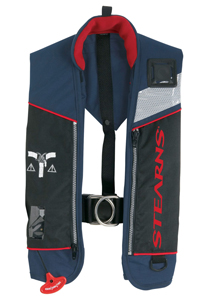 |
|
Wearing an inflatable PFD, like this unit from Stearns, increases your chances should you fall overboard, especially at night. |
|
Courtesy Stearns |
Combining emergency lights with EPIRBs was the logical next step, and ACR does just that with its ResQLink series of beacons that broadcast emergency signals to the 406-MHz global satellite system. This will bring rescuers to your vicinity, and then a 121.5-MHz signal allows them to home in on your location. Sounds great on paper, but personally I’m not sure of the worth of this for many offshore MOB situations on cruising boats, where your only realistic hope of rescue in time is to have your own mother ship find you. The Hammerhead Automatic Radio Direction Finder by RF Finding Systems is designed to solve this problem by allowing easy “homing” on the 121.5-MHz frequency put out by EPIRBs. Sea Marshall makes the small AU9 alerting unit for personal use, which transmits on the long-range 121.5-MHz frequency and has base units for onboard tracking and location of the signals.
ACR Artex and others answer the direction-finding question with products like AISLink, which transmits a VHF AIS signal and alert to any vessels in the vicinity equipped with AIS and DSC radios. The AIS alert includes a position derived from an internal GPS unit, making locating the victim much easier whether night or day.
ACR Artex explains, “The AISLink MOB also has the ability to alert your crew to the emergency by activating the DSC alarm on your vessel’s VHF. All AIS receivers and AIS-enabled plotters within a five-mile radius (dependent on conditions) are alerted, and an integrated high-intensity strobe light assists with accurate positioning, even in low light conditions.”
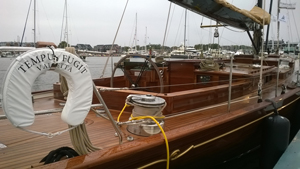 |
|
The classic horseshoe buoy at the stern provides a quick way to get flotation to an MOB. |
|
John Kettlewell |
Similarly, McMurdo’s Smartfind S10 and S20 AIS devices seem like the perfect personal locator beacons for pleasure craft. These can be set up to automatically deploy in concert with your inflatable life jacket; this could be the difference between life or death if the MOB is incapacitated. The ability to plot AIS information on the boat’s chartplotter would allow you to use the GPS position to route the vessel back to the victim.
Ocean Signal is another supplier of personal locator devices. They claim their MOB1 is the smallest device with integrated AIS and DSC, but it still retains a 24-hour operating life and a seven-year battery life. The small size would make it more likely to be used in the first place.
Since there is always an “app for that,” the OLAS system by Ultimate Sports Engineering utilizes a small transmitter that can be worn like a wristwatch or attached to a life ring or life jacket, along with a mobile app that records the MOB position when triggered by the OLAS device moving out of range. Note that this only records the last known position and is not a continuous tracker. The app, of course, relies on the internal GPS unit of the phone or laptop, which is a limitation for those voyaging offshore.
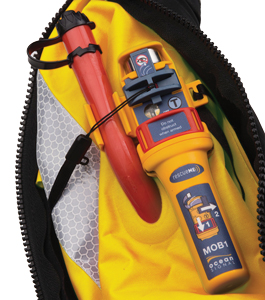 |
|
The MOB1 unit from ACR is a personal AIS unit with a built-in GPS that transmits your position via VHF DSC. |
|
Courtesy ACR Electronics |
Another important piece of the layered approach to location is to utilize your boat’s main GPS unit to record the location when an MOB situation takes place. I’ve found that no matter how simple the operation of the unit, it is important to post printed directions next to the GPS to remind yourself or other crew of what to do in an emergency. Never assume that whatever gear the MOB has with them will actually work or that the person in the water will know what to do. Similarly, I always have a notepad and pens/pencils right next to the helm to write down whatever we need to know. I have used these simple tools many times to record safety information coming over the radio, and even to occasionally note emergency calls and positions.
Even the humble hand-held VHF radio could be an important tool in an MOB situation. Choose a model that is small and waterproof, and you’ll find you use it in lots of other situations, so when an emergency happens you’ll know what to do. Dedicated emergency VHF radios offer powerful batteries that retain a charge for long periods of storage. Ocean Signal makes the V100 emergency hand-held VHF with lithium battery pack for long life. The radio can still be tested using normal disposable alkaline batteries to make sure all is working, while the main battery does not get depleted.
The golden retrieval
Okay, we’ve located the MOB using a combination of skill, great equipment and lots of luck. Suddenly we realize that 200-pound Bob weighs a lot more soaking wet, and he’s not in the best of shape after bobbing around in the cold ocean for 30 minutes in the dark. Getting that sodden soul back on board can be tough. One of the more popular approaches, judging by what I observe on sterns all over the world, is the Lifesling2 package by West Marine. The pack itself comes with instructions printed on the outside, which are very helpful, but the idea is simple: Throw the flotation ring off the stern with its line presumably well secured to the boat; then, motor around the MOB until the ring and line can be grabbed by the person. If the MOB can get it over their head with their arms above the unit, the victim can be pulled to the boat where hopefully you can winch them on board with a halyard or other means. Plastimo makes the Rescue Sling with similar functionality.
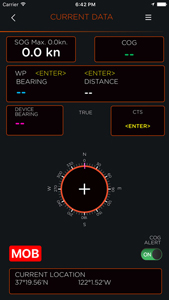 |
|
The Overboard Location Alert System (OLAS) uses your phone and Bluetooth tags worn by crewmembers to alert you if an MOB occurs. |
|
Courtesy Ultimate Sports Engineering |
The Switlik MOM units mentioned above include built-in straps designed for hauling a person out of the water, which is not something found on typical life rings or horseshoe buoys.
Just Marine, another company that makes inflatable life ring and marker combos, also makes the innovative Recovery Ladder. The unit mounts between cleats or strong points on the side of the boat and provides both a ladder for climbing and an option to winch up a person who is floating alongside the boat. The bottom of the ladder is connected to a halyard and then the person is rolled up the side of the boat. It’s hard to describe, but easier to see — check out the pictures at marine.the-justgroup.com. The company also offers the Sea Scoopa, a mesh “sail” that can be used to net the MOB and haul them on board. They also offer a product called Reelsling that is similar to the Lifesling in operation.
Again, the belt-and-braces approach is the best, and I would not rely on any single piece of gear to be the only option. For example, many cruising boats have deep scoop sterns with boarding steps, which could be an excellent boarding location. Even if the victim can’t pull themselves up a stern ladder, it might at least give them a sturdy handhold to help remain with the boat until a lifting rig can be deployed. Typically, most sailors plan on using a halyard to haul the MOB on board. If you’ve done this to haul and launch a dinghy when in harbor, you know how difficult the task can be — even with a rig often weighing less than a full-grown man.
One option I can imagine working would be bringing the person alongside where they could be clipped or tied to a long line led from a mast cleat to the MOB and then back to a cockpit winch. The crew could then use the powerful cockpit winch to gradually raise the person out of the water (West Marine offers various Lifesling hoisting tackle packages). Needless to say, these scenarios would be well worth testing in the harbor on a sunny day with warm water.
Just don’t do it!
Even with the best-laid plans and a full crew on board, MOBs from race boats are not always retrieved in time. So, make item No. 1 on the list your top priority — stay on board no matter what, then set up a location plan and system utilizing gear that is easy to deploy and effective. Make sure your crewmembers all have the means to stay afloat and let their positions be known. Ensure everyone on board knows what to do, and practice getting a person out of the water under non-ideal conditions.
John Kettlewell is a freelance writer and photographer.
MOB manufacturers |
||
|---|---|---|
| ACR Artex www.acrartex.com |
RF Finding Systems www.rffindingsystems.com |
|
| Dan Buoy www.danbuoy.com |
Stearns www.coleman.com/stearns-recreational-inflatables |
|
| Forespar www.forespar.com |
Switlik www.switlik.com/marine |
|
| McMurdo Marine www.mcmurdomarine.com |
ThrowRaft www.throwraft.com |
|
| Mustang Survival mustangsurvival.com |
Ultimate Sports Engineering www.ultimatesportsengineering.com |
|
| Ocean Signal oceansignal.com |
Weems & Plath www.weems-plath.com |
|
| Plastimo www.plastimo.com |
West Marine www.westmarine.com |
|

